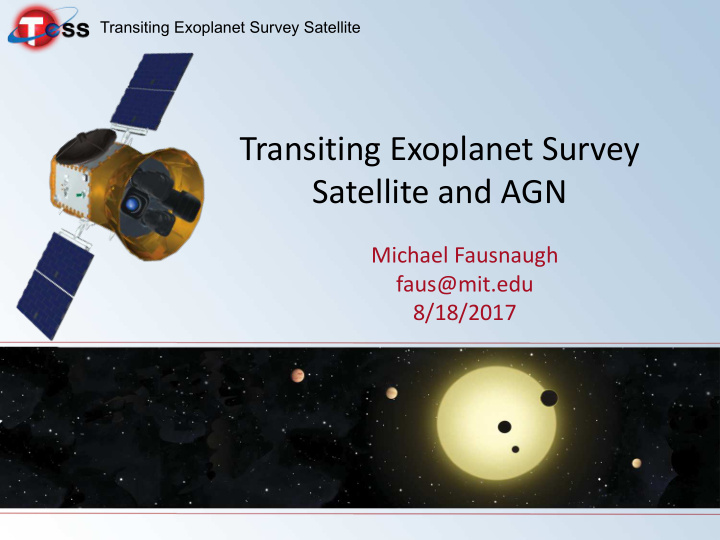



Transiting Exoplanet Survey Satellite Transiting Exoplanet Survey Satellite and AGN Michael Fausnaugh faus@mit.edu 8/18/2017
u Level 1 Science requirement: § Masses for 50 planets with radius < 4R_Earth u Search many bright stars § Discovery by transits § Masses by follow-up (RV) u Transits require: rapid cadence (minutes) § § high precision (earth around sun is ~100 ppm) u Challenges for extra-galactic astronomy, but…. § Unique cadence/precision for variability studies § Many objects (nearly whole sky) 2
3
4
75 � 60 � 45 � Ecliptic Latitude 30 � 15 � � 90 � � 60 � � 30 � 0 � 30 � 60 � 90 � 120 � 150 � � 150 � � 120 � 0 � � 15 � � 30 � � 45 � Milky Way � 60 � � 75 � Ecliptic Longitude 5
6
10.5 cm aperture 0.6 to 1.0 microns (like I _c) u u 24x24 degree FOV (x4) Targeted pixels u u 2300 square degrees per pointing 2 minute cadence § § Four 2048 x 2048 CCDs (x4) Full Frame Images (FFIs) u u ~21 arcseconds/pixel 30 minute cadence § u No propriety period u 7
u Possible Science Cases? u Variability Catalog § RM campaigns have been inefficient (50% ”success”) § Identify variable ones (high amplitude) for future planning Even if it fails, a questions about what changed • § No need to trace past null results (though long baseline is great!) occasionally comes up with referees • § Find odd behavior (flares, changing-look, non-stationary states….) § Why are some variable and others aren’t?** Large sample • 8
10 4 10 3 Number of AGN 10 2 10 1 10 0 2 4 6 8 10 12 Number of Sectors 9
10 3 10 2 Number 10 1 ∼ 1 month ∼ 1 year 0 . 5 1 . 0 1 . 5 2 . 0 2 . 5 3 . 0 Redshift 10
∼ 1 month 10 3 ∼ 1 year Number 10 2 10 1 45 46 47 48 49 log L Bol 11
u Possible Science Cases? u Structure functions/PSD estimation § Hours to days have been examined for only ~20 objects (Kepler [?]) § Will (still) have systematics Thermal impulses every 2 weeks • Thermal/focus variations along orbit • Differential Velocity Aberration • § baseline is generally short § Not independent of noise (and therefore mag) 12
u Possible Science Cases? u Individual Targets § TESS images/light curves are free and public! § Light curves will (probably) be excellent 30 minutes • S/N ~100 at I = 16 (?) • § Easy to point: where is the sun? § Very red pass-band (dust emission my contaminate) § Pixels are large (crowded/blended photometry) 13
u Possible Science Cases? u Discovery § A small fraction of AGN that exist are known, esp. in the Southern Hemisphere § Variability selection (follow-up to confirm) § Needs rapid variability (so, low mass/luminosity….) § Or maybe fill out the south ecliptic pole in advance with traditional techniques? Sufficiently easy? How much area/depth before interesting/useful? • 14
75 � 60 � 45 � Ecliptic Latitude 30 � 15 � � 90 � � 60 � � 30 � 0 � 30 � 60 � 90 � 120 � 150 � � 150 � � 120 � 0 � � 15 � � 30 � � 45 � Milky Way � 60 � � 75 � Ecliptic Longitude 15
u Guest Investigator Program u Due Sept. 29, 2017 u Nominal awards of $50k -- $200k to use TESS data for aux. science u Can propose new 2-minute targets or use FFIs u Some grey areas: § E.g., early access to data? u Technical questions: Patricia Boyd patricia.t.boyd@nasa.gov. u NASA point of contact: Martin Still martin.still@nasa.gov. 16
Recommend
More recommend